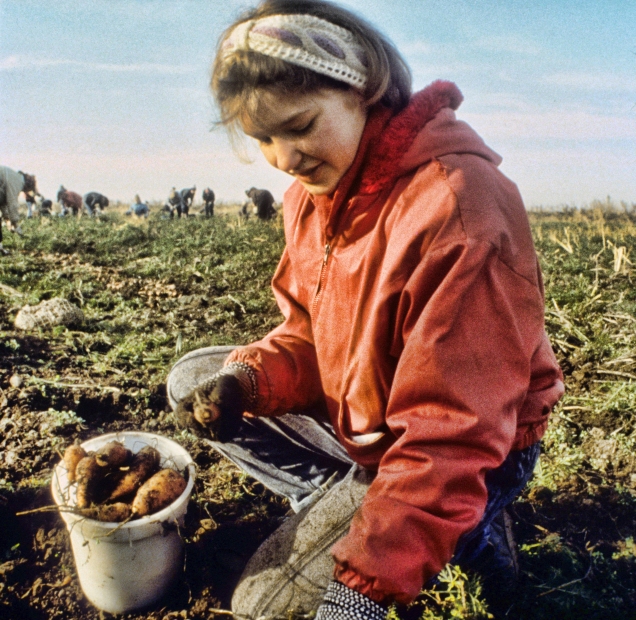A girl harvests carrots with her classmates on a collective farm outside of Khabarovsk
OCTOBER, 1992
Carrots. Carrots. Carrots. Every dinner, whether we have borscht, chicken, or ham, we eat carrots. Yesterday, I finally found out why. Tina, who cooks all the meals in our household, teaches history at School #13. For a few weeks every fall, most schools here send their older students to the government-owned farms and collectives to help with the harvest. School #13 and five other schools are responsible for harvesting carrots from a 40-acre field on the outskirts of Khabarovsk. Even my English-language students at the teachers’ college help with the harvest.
“Everybody for the Glory of Labor,” or so the Communist slogan goes. Now that the Communists are gone, the practice continues, but not for the glory of labor. It’s for the calories.
I visited School #13 today. All the children age 11 and older were gathered outside the school. They were holding metal lunch buckets and dressed in play clothes. Some children wore rubber boots. Six buses arrived, and I climbed aboard with Tina’s class. During our 25-minute ride to the farm, some of the children told me they’d rather pick carrots than do school work. “It’s like a holiday for us,” said one 15-year-old girl. Every child is officially allowed to take home five carrots per day, although many take home more. In addition, for every 170 kilograms picked, the school is paid 100 rubles — about 30 cents — to be divided among the children, with the hardest working getting the most money. The idea of paying the children is a new one. Until two years ago, they only received carrots.
When we reached the farm, the children were separated into small groups. Without much prodding, they began picking carrots, weighing them and packing them into mesh bags. The children talked and laughed as they worked, occasionally breaking carrots and leaving them in the dirt. A farm supervisor watched over them. Without the children, almost all of the carrots would stay in the fields she said.
The school’s principal Valentina Shepelyova walked up and down rows of carrots while issuing commands. She said labor teaches character. “They’re learning how to behave not as individuals but as part of a collective.”
But what about proposals to privatize farms? Wouldn’t this put an end to student labor? “The privatizing will not come for a long time,” she replied. “It’s difficult to change our attitude towards land.”
I was the first American these children had ever seen. At one point, about 15 children encircled me and peppered me with questions: “Do American children go to farms?” “How long do they stay in school?” “Who picks your crops?”
They stopped to eat lunch. Afterwards, their own buckets filled with carrots for home, they climbed back on the buses, leaving behind large bags of carrots to be gathered up by farm workers. Some of the girls sang songs during the ride home. The older boys sat in the back. Unlike American children, Russian children behave themselves on a bus. I found out why. When an older boy tossed a carrot out the window, the bus driver thrust his foot on the brakes, marched up to the boy, grabbed him by the collar, and pulled him to the front. “Go get the carrot!” he shouted, shoving the boy out the door. Then he closed it. The children erupted into laughter as they watched the carrot-thrower — now getting smaller and smaller as we drove away — shake his fists in the air.
